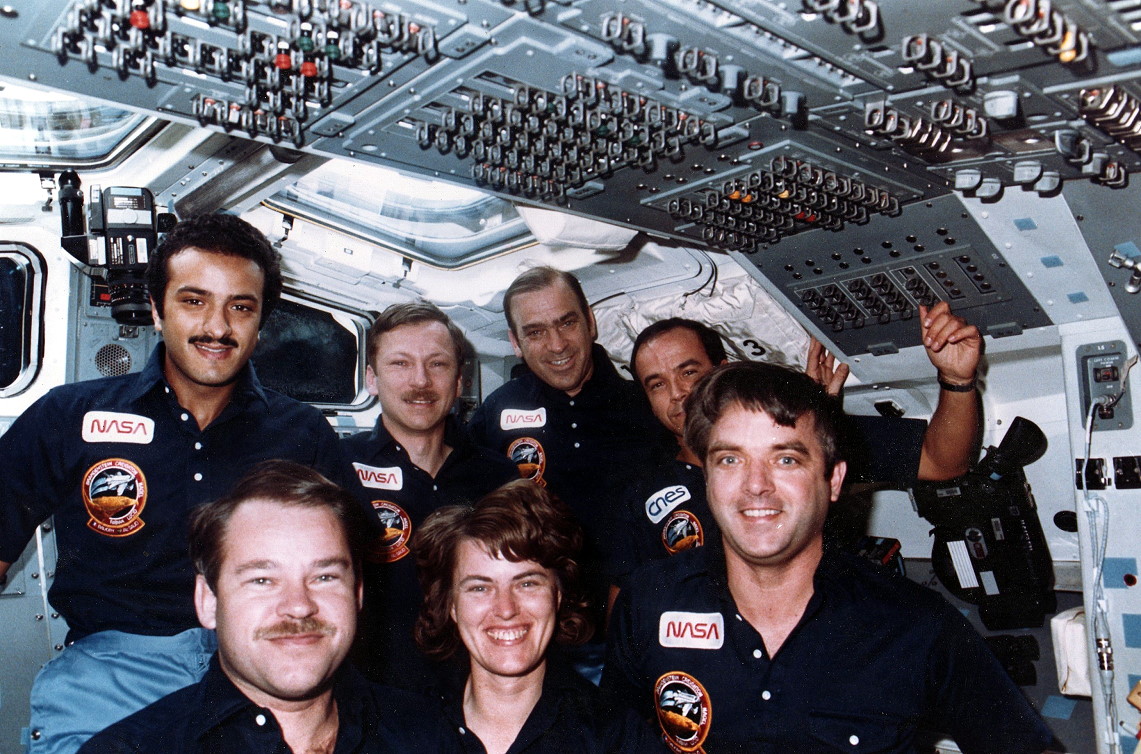
Thirty years ago, on 17 June 1985, the seven-strong crew of the 18th shuttle mission rocketed into orbit with a cargo of three commercial communications satellites, a free-flying astronomical observatory, the oldest woman yet to travel into space, and representatives of no fewer than three discrete nations—the United States, France, and Saudi Arabia—packed aboard Discovery. Mission 51G was the fourth of nine shuttle flights which would be undertaken in 1985, the year preceding the calamitous loss of Challenger, and it marked the high-watermark of a time in which the reusable fleet of orbiters were in the midst of a “Golden Age” of dazzling achievements. As described in yesterday’s history article, the flight had attracted more than its fair share of controversy, on religious, cultural, and technological grounds, but would turn out to be a remarkable success.
Tradition had long since dictated that the evening before launch was spent with spouses at the deserted “beach house” on Cape Canaveral’s Neptune Beach waterfront, enjoying a barbecue dinner and private time in seclusion, with only the neighboring launch complexes and the lapping waves of the ocean for company. Even today, the building, officially known as “The Kennedy Space Center Conference Center,” still possesses dusty old wine bottles, emblazoned with crew patches and signed by astronaut crews. “This cabin is located … maybe a mile away from the launch pad,” explained 51G pilot John Creighton in a NASA oral history. “Most of the time, when the vehicle sits on the launch pad … it’s covered by the Payload Changeout Room, sort of a cocoon to protect it from the weather. Well, that night before launch, when they rolled that back and they were in the process of fueling the vehicle, it’s illuminated by these bright searchlights … and you walk up the beach for maybe a half-mile toward the vehicle. You can get a pretty good view of it.” Returning to the beach house, the 51G crew and their spouses toasted their flight with a bottle of wine, then parted. The astronauts went back to their quarters, keenly aware that launch was scheduled for early on 17 June and they would be awakened at around two in the morning.
“NASA has everything scripted right down to the minute,” Creighton recalled, “and they wake you up about four hours and 45 minutes before launch and you … take a quick shower and get dressed and go in, still half-asleep, into breakfast, and a bunch of photographers run in and take your picture and they bring out a big fancy cake with your patch on it. Nobody feels like eating cake at four o’clock in the morning and it’s kept and eventually you get a chance to eat it when you celebrate after you get back.” Suiting-up came next, followed by the ceremonial walk-out from the Operations and Checkout Building and the bus ride to Pad 39A. Although it was still dark, 800 million candlepower of xenon illuminated shuttle Discovery like a torch. Silence reigned across the launch complex, punctuated only by the creaking and groaning of gaseous propellants boiling off from the External Tank. Commander Dan Brandenstein entered the vehicle first, followed in turn by Creighton and Steve Nagel, who took the flight engineer’s seat behind and between the two pilots. “Nagel,” said mission specialist John Fabian, as he was being strapped in downstairs on the middeck, “you’re in for one hell of a ride!”
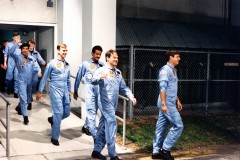
There were no technical problems, the weather was good, and at T-5 minutes Creighton was given the go ahead to start Discovery’s Auxiliary Power Units (APUs). This was easier said than done. “On a typical airplane,” Creighton recalled, “you’ve got one switch to start the APU. Well, on the shuttle, you’ve got eighteen switches! You have three APUs, instead of one, but you’ve got six switches to pressurize the fuel tanks and power up the controllers and each of these switches has got an abbreviation of the word ‘control’ or ‘controller’ on it … and it’s hard to see. On launch morning, you look at every switch and you look at your checklist, you look at the switch … because they’re not straight in order. You want to make sure you don’t mess that up.” Creighton had barely finished with the APUs when the call came for the crew to close their visors.
Autosequence Start commenced at T-31 seconds, and after reaching the eight-second point, all voice contact was virtually impossible, as Discovery’s three main engines thundered to life at 7:33 a.m. EDT. “The whole vehicle starts rumbling and shaking,” Creighton continued, “and you can’t believe that these big bolts are still holding you to the ground. It feels like it’s trying to rip itself off the ground.” From his seat, Nagel remembered seeing Brandenstein and Creighton vibrating in their seats as first the engines, and then the Solid Rocket Boosters (SRBs), ignited. “And I remember I just was mentally behind,” he said. “I think I was left on the launch pad with my mind, trying to keep up. It just all happened so fast. There was such a rush of events and the sights and sounds … were almost overwhelming.” During the ascent, Creighton had chance to look through his window and was rewarded with a panoramic view along the Florida coastline. It was only fleeting, for his job was to monitor the engines, and he promptly got back to work.
As Discovery gained velocity and reached the edge of space, Creighton could not believe how quickly the sky darkened from blue to deep indigo to the pitchest black. The separation of the boosters unleashed a bright flash in the cabin, totally engulfing the front windows in flame for about half a second, and the ride continued under the sustained, quiet push of the main engines. At 7:41 a.m. EDT, eight minutes since leaving Florida, the magical call of “MECO” (“Main Engine Cutoff”) brought a cheer from the crew and a force of three times of terrestrial gravity was gone, to be replaced by … weightlessness.
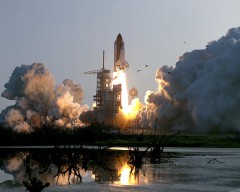
There was precious little time to acclimatize to their new surroundings, for John Fabian and fellow mission specialist Shannon Lucid were tasked with the deployment of three communications satellites: Arabsat-1B on behalf of the Arab League, Morelos-A for Mexico, and America’s Telstar-3D. They were also assigned to support the deployment and retrieval of the free-flying Shuttle-Pointed Autonomous Research Tool for Astronomy (SPARTAN), using the shuttle’s Remote Manipulator System (RMS) mechanical arm for two days of independent scientific observations.
For Fabian, who had flown as part of a smaller crew on STS-7 in June 1983, it posed its own challenges. “We had a crew of seven, living inside a volume about the size of a minivan,” he told the NASA oral historian, “and so we were good neighbors for a week!” Eight hours after launch, at 3:37 p.m. EDT, the first of Discovery’s load of three communications satellites was successfully deployed when Morelos-A was sent spinning into space, affixed to its Payload Assist Module (PAM)-D motor. This payload was particularly important, since it represented Mexico’s first communications satellite, with a mission to provide educational and commercial television programs to the most remote regions of the country, together with telephone and fax services and business and data transmissions. Arabsat followed some 26 hours after launch, on 18 June, and Telstar-3D departed the payload bay at 7:20 a.m. on the 19th.
Next came SPARTAN, a unique retrievable platform with an name that even NASA’s best acronym-makers could be justly proud of: the Shuttle Pointed Autonomous Research Tool for Astronomy. It was a 2,200-pound (1,000-kg) cube-shaped box, equipped with instruments to perform medium-resolution mapping of X-ray emissions from extended sources and regions in the Universe. Built by NASA’s Goddard Space Flight Center of Greenbelt, Md., SPARTAN was intended to be flown repeatedly, at intervals of between six and nine months, with data stored on internal tape recorders and pointing and stabilization achieved by a three-axis attitude control system. Deployed and retrieved by the RMS, the satellite was reusable and had been assigned a second mission, in January 1986, to observe Halley’s Comet. Specific objectives for its maiden voyage on Mission 51G were areas of hot gas in a large cluster of galaxies within the constellation Perseus and within the centre of our own galaxy, the Milky Way.
The rendezvous operations associated with SPARTAN were straightforward, according to Nagel, for the crew had already spent months rehearsing the retrieval of the Long Duration Exposure Facility (LDEF) and many of the techniques were similar. Shannon Lucid was responsible for the deployment, which occurred two minutes after midday EDT on 20 June, whilst Fabian handled the RMS for the retrieval, about 45 hours later, at 9:30 a.m. on the 22nd. The small spacecraft reached a maximum distance of about 100 miles (160 km) from Discovery. As for the pilots, Creighton maneuvered Discovery to a safe separation distance after deployment, whilst Brandenstein took the lead in the rendezvous and retrieval.
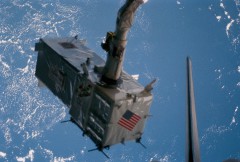
“But when we came back in to retrieve it,” Fabian told the oral historian, “it was out of attitude. It was supposed to be in an attitude which would be easy for us to just fly up to and grab. It turned out that the grapple fixture—instead of being out-of-plane to the vehicles, so that we could just go in and get it—was on top.” One solution was for Brandenstein to fly an out-of-plane maneuver, which the crew had not practised on the ground, but it was decided to bring SPARTAN closer to the shuttle “and then reach over the top with the arm and grab it from the top.” As a consequence, the final grapple of the payload was an “off-nominal” event, but it left Fabian with a great deal of pride—not only in his training and his capabilities, but in the ability of the crew as a whole to execute an unplanned maneuver.
Downstairs, on the middeck, Frenchman Patrick Baudry and Saudi Arabia’s Sultan Abdul-Aziz Al-Saud tended to their own experiments. The French Echocardiograph Experiment (FEE), which had been bumped from the payload manifest of Mission 51E, employed a non-invasive, ultrasonic technique to obtain data on the physiological adaptation to the microgravity environment, including the pooling of blood in the head and upper torso and changes in the size of heart cavities and differing flow rates in major arteries. Located in two middeck lockers—one housing the electronics, the other holding the video recording equipment and control monitor—the FEE was conducted primarily by Baudry, assisted by Lucid. Another pair of lockers were occupied by the French Postural Experiment (FPE), which was designed to better understand changes in muscular tone, posture, orientation, and movement in the strange environment. Baudry and Al-Saud worked together on this experiment. The Automated Directional Solidification Furnace (ADSF)—“a pilot’s experiment,” joked Steve Nagel, since it needed little more than a couple of switch throws to operate—melted composite material samples of bismuth and manganese and resolidified them in a series of four small furnaces.
One of the more notable experiments was a study from President Ronald Reagan’s Strategic Defense Initiative (SDI, or “Star Wars”), which sought to evaluate the ability of a ground-based, low-energy laser to track a moving object in orbit. The High Precision Tracking Experiment (HPTE) consisted of a retroreflector, mounted in a cylindrical housing, which was placed on the middeck side hatch window to receive and reflect a four-watt green laser beam projected from a test site in Maui on Hawaii’s Big Island. “The first time we tried, it didn’t seem to work,” remembered Creighton. “We figured it out, actually, about the same time that the ground did, but it turned out that when you put the units into the computer, we used the wrong units! As we passed over [Maui], we were actually tracking a point that was above us, instead of below us. We figured it out, updated the computer co-ordinates and then we weren’t passing over Hawaii, so we had to wait about 24 hours and do it the next day.”
For the payload specialists, the once-in-a-lifetime opportunity of flying in space was something to be savored. For Al-Saud, his Wow moment was seeing Saudi Arabia for the first time from space. “I was woken up by some crew members,” he told a television interviewer. “The Earth was ‘above’ us and I saw the Eastern Province with its lights. It was a very moving sight.” For the sultan, though, the happiest moment was returning to Earth. For fighter pilot Patrick Baudry, who had carried French fare into orbit—jugged hare, lobster, crab mousse, chocolate pudding, and some small bottles of wine—the strangest thing was to have someone else (Brandenstein) actually land the vehicle. Referring to the fact that 51G was Brandenstein’s first landing in the commander’s seat, Baudry said afterwards, “It’s the first time I’ve ever flown on a plane for the first time, with anybody that was landing it for the first time, where I wasn’t doing it!”
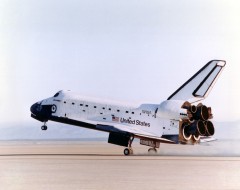
“Well,” replied Brandenstein, with a grin, “look at that. We were able to walk away from it!”
Touchdown at Edwards Air Force Base, Calif., on 24 June came at 6:12 a.m. PDT (9:12 a.m. in Florida), completing a mission of just over seven full days, and NASA remarked that Mission 51G was its most successful flight to date. The next few weeks were filled with post-flight public relation tours, which included foreign trips in which the astronauts were treated, quite literally, like kings and queens. “We flew on Saudi Airlines, out of New York into Jeddah, first class, on a 747,” Nagel recalled. “They really took care of us.” Spouses were invited along to places normally excluded to women and the astronauts dined on traditional Bedouin fare and camel’s milk, sitting cross-legged on carpets, then visited the Saudi royal family’s summer palace in the mountainous Abha region. It was an experience that Nagel could only compare to a Cinderella-type story.
John Fabian also keenly remembered the trip, not for being one of the 51G astronauts … but for being the nephew of an old Arab-American Oil Company (ARAMCO) oil employee. “I mentioned to the President of ARAMCO,” he said, “that my uncle had spent 35 years working in the oilfields of Saudi Arabia.” When the top-ranking oil official asked for the name of Fabian’s uncle, it turned out to have been his first boss! The Americans returned to the United States with “gifts, gifts, gifts,” according to Fabian—several leather briefcases, a handful of expensive Swiss watches, a Turkish carpet, an engraved watch with King Fahd’s signature on its face, to name just a few—although Shannon Lucid, the only female member of the 51G crew, almost got herself into diplomatic hot water.
“She had no love for the Saudis,” said Fabian. “She had no love for the Muslim religion. She particularly objected to Saudi treatment of young women and disfigurement … and she didn’t want to be a part of any of that. There was a lot of time and effort spent convincing her otherwise, to absolutely no avail.” When the other astronauts arrived in Riyadh, they were greeted by Al-Saud, who looked around for Lucid. Her absence did not go down well with the sultan or the king … or with President Ronald Reagan. “Well, the King called the President,” recalled Fabian. “The President called the NASA Administrator. The NASA Administrator called the Johnson Space Center Director, who called George Abbey … and Shannon was on the next 747!”
Lucid may have lost the battle, but she won the war, for she spent barely a day in Saudi Arabia, shook King Fahd’s hand, and returned promptly home. In his 2006 memoir, Riding Rockets, fellow astronaut Mike Mullane had a slightly different recollection of the story. “Shannon’s husband could not make the trip,” he wrote. “Shannon wasn’t concerned. She didn’t need a man to hold her hand. Wrong. Saudi Arabia did not allow women to enter the country alone. She had to have a male escort. When Shannon heard this, she told [NASA] Headquarters she wasn’t going.” It was decided to admit Lucid into Saudi Arabia as the honorary daughter of Dan Brandenstein or the honorary sister of John Fabian or, worst of all, as an honorary man! “I immediately went to Shannon’s office and congratulated her on having achieved the highest honor a woman could ever hope to achieve: to be designated an honorary man,” Mullane continued. “Shannon had a lively sense of humor and laughed at my antics … but I made certain not to walk down the stairs in front of her for the next few weeks!”
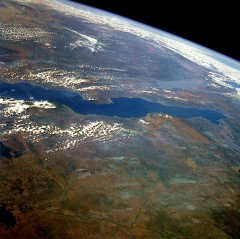
The trip to France proved upsetting for the wives of Brandenstein, Fabian and Nagel and for Creighton’s bride-to-be, Terry, because all were barred. “We went without spouses,” Fabian told the oral historian, “because the French couldn’t make up their mind what they were going to do with the spouses, and the reason they couldn’t make up their mind … is because Patrick Baudry was in the middle of a divorce and he had a Russian girlfriend, who was the daughter of a KGB agent!” In the astronauts’ minds, not only did they have to endure the wrath of their wives—“[The news] was certainly not popular in my house,” recalled Fabian, whilst Creighton admitted that it remained “a sore subject” in his home, too—but preventing them from visiting France and touring Paris and Nice and Marseilles was perceived to be an immense slap in the face for spouses who had supported their husbands through more than seven years of astronaut training and preparation.
Whilst in France, the crew were inducted into the Bordeaux Wine Society, having presented the organization with one of the four small bottles which Baudry carried into orbit. Perhaps in the case of Creighton, the disappointment over the absence of spouses had been sweetened by his wedding … only a day after landing from the mission. “Originally, I’d planned to get married at the Cape,” he recalled, “because we were going to come back and land at the Cape, but then … about three weeks before the flight [it was] decided [we should] land in California. They flew Terry out for the landing, but the families weren’t going to be out there, so we just made a quick snap decision we’d get married in Houston, after I got back, and any of the families that could cycle through Houston on their way back from the Cape. Most of the family made it.”
Adventure, indeed, is not an excessively poetic term for the mission, for Discovery’s mission offered precisely that. Years later, astronaut Joe Engle recalled a conversation with Al-Saud and the sultan offered a considered, “classic,” view of what beholding the Home Planet from on high actually meant to him. “The first day or two in space,” Al-Saud said, “we were looking for our countries. Then, the next day or two, we were looking at our continents. By about the fourth or fifth day, we were looking at our world!” In Engle’s mind, this was exactly right. It was another reminder that national and international boundaries mean little to spacefarers—gazing down, there are no atlas-like lines or visible barriers between the countries. From space, Earth appeared as it should be: as one world.
Perhaps flying royals and politicians into space was a wise move, after all.
This is part of a series of history articles, which will appear each weekend, barring any major news stories. Next week’s article will focus on the 20th anniversary of STS-71, the first shuttle-Mir docking mission in June 1995, which inaugurated a period of co-operation between Russia and the United States, which endures to this very day.
Want to keep up-to-date with all things space? Be sure to “Like” AmericaSpace on Facebook and follow us on Twitter: @AmericaSpace




I see it was not added that one astronaut on that mission later commented that the Saudi “astronaut” spent most of his time staring out the windows of the Space Shuttle and pretty much just got in the way of the real astronauts.
I can only imagine how galling it must have been to let this prince and those senators fly before real astronauts who had trained years to be up there, where they could do real work and real science.
Hmmm. Putting a Saudi prince, member of the ruling royal family, on board a shuttle flight with minimal training to observe (NOT participate in) the launch of a comsat for the Arab League, one of whose members, the PLO, was then engaged in a very high-profile hijacking. Sounds like “Muslim Outreach” to me. But we won’t call it that, since the sainted Reagan was President then, not the hated Obama. Right, conservatives?
Space is the one place where the right and left are exposed for the divide and conquer scammers they are. Because of space dollar and corporate constituencies- and a certain campaign contribution many years ago by an internet wunderkind- the political landscape of space exploration is a hopeless and ridiculous jumble.
It is like heaven shining down a sacred illuminating lesson for us stupid brainwashed partisans to marvel at. Of course we just ignore it and continue to try and blame someone not-of-our-party.
The brain dead of the right or left should not be allowed to comment here.